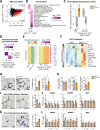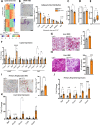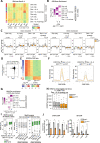Glucocorticoid activation of anti-inflammatory macrophages protects against insulin resistance
- PMID: 37080971
- PMCID: PMC10119112
- DOI: 10.1038/s41467-023-37831-z
Glucocorticoid activation of anti-inflammatory macrophages protects against insulin resistance
Abstract
Insulin resistance (IR) during obesity is linked to adipose tissue macrophage (ATM)-driven inflammation of adipose tissue. Whether anti-inflammatory glucocorticoids (GCs) at physiological levels modulate IR is unclear. Here, we report that deletion of the GC receptor (GR) in myeloid cells, including macrophages in mice, aggravates obesity-related IR by enhancing adipose tissue inflammation due to decreased anti-inflammatory ATM leading to exaggerated adipose tissue lipolysis and severe hepatic steatosis. In contrast, GR deletion in Kupffer cells alone does not alter IR. Co-culture experiments show that the absence of GR in macrophages directly causes reduced phospho-AKT and glucose uptake in adipocytes, suggesting an important function of GR in ATM. GR-deficient macrophages are refractory to alternative ATM-inducing IL-4 signaling, due to reduced STAT6 chromatin loading and diminished anti-inflammatory enhancer activation. We demonstrate that GR has an important function in macrophages during obesity by limiting adipose tissue inflammation and lipolysis to promote insulin sensitivity.
© 2023. The Author(s).
Conflict of interest statement
The authors declare no competing interests.
Figures





Comment in
-
Glucocorticoid activation of macrophages protects against insulin resistance.Nat Rev Endocrinol. 2023 Jul;19(7):380. doi: 10.1038/s41574-023-00850-3. Nat Rev Endocrinol. 2023. PMID: 37173438 No abstract available.
Similar articles
-
Glucocorticoid-induced insulin resistance is related to macrophage visceral adipose tissue infiltration.J Steroid Biochem Mol Biol. 2019 Jan;185:150-162. doi: 10.1016/j.jsbmb.2018.08.010. Epub 2018 Aug 23. J Steroid Biochem Mol Biol. 2019. PMID: 30145227
-
CD40 deficiency in mice exacerbates obesity-induced adipose tissue inflammation, hepatic steatosis, and insulin resistance.Am J Physiol Endocrinol Metab. 2013 May 1;304(9):E951-63. doi: 10.1152/ajpendo.00514.2012. Epub 2013 Mar 12. Am J Physiol Endocrinol Metab. 2013. PMID: 23482447 Free PMC article.
-
Inhibition of M1 macrophage activation in adipose tissue by berberine improves insulin resistance.Life Sci. 2016 Dec 1;166:82-91. doi: 10.1016/j.lfs.2016.09.025. Epub 2016 Oct 1. Life Sci. 2016. PMID: 27702567
-
Cellular and molecular players in adipose tissue inflammation in the development of obesity-induced insulin resistance.Biochim Biophys Acta. 2014 Mar;1842(3):446-62. doi: 10.1016/j.bbadis.2013.05.017. Epub 2013 May 22. Biochim Biophys Acta. 2014. PMID: 23707515 Free PMC article. Review.
-
Adipose tissue macrophages and their role in obesity-associated insulin resistance: an overview of the complex dynamics at play.Biosci Rep. 2023 Mar 31;43(3):BSR20220200. doi: 10.1042/BSR20220200. Biosci Rep. 2023. PMID: 36718668 Free PMC article. Review.
Cited by
-
Lingguizhugan Decoction Improved Obesity by Modulating the Gut Microbiota and its Metabolites in Mice.Curr Drug Metab. 2024;25(4):276-287. doi: 10.2174/0113892002289388240705113755. Curr Drug Metab. 2024. PMID: 38982915
-
Mechanisms of epigenomic and functional convergence between glucocorticoid- and IL4-driven macrophage programming.Nat Commun. 2024 Oct 18;15(1):9000. doi: 10.1038/s41467-024-52942-x. Nat Commun. 2024. PMID: 39424780 Free PMC article.
-
Intestinal flora and bile acid interactions impact the progression of diabetic kidney disease.Front Endocrinol (Lausanne). 2024 Sep 20;15:1441415. doi: 10.3389/fendo.2024.1441415. eCollection 2024. Front Endocrinol (Lausanne). 2024. PMID: 39371929 Free PMC article. Review.
-
Mechanisms of Epigenomic and Functional Convergence Between Glucocorticoid- and IL4-Driven Macrophage Programming.bioRxiv [Preprint]. 2024 Feb 18:2024.02.16.580560. doi: 10.1101/2024.02.16.580560. bioRxiv. 2024. Update in: Nat Commun. 2024 Oct 18;15(1):9000. doi: 10.1038/s41467-024-52942-x. PMID: 38405750 Free PMC article. Updated. Preprint.
-
Acetylation-induced proteasomal degradation of the activated glucocorticoid receptor limits hormonal signaling.iScience. 2024 Jan 18;27(2):108943. doi: 10.1016/j.isci.2024.108943. eCollection 2024 Feb 16. iScience. 2024. PMID: 38333702 Free PMC article.
References
-
- Finucane MM, et al. National, regional, and global trends in body-mass index since 1980: systematic analysis of health examination surveys and epidemiological studies with 960 country-years and 9·1 million participants. Lancet. 2011;377:557–567. doi: 10.1016/S0140-6736(10)62037-5. - DOI - PMC - PubMed
Publication types
MeSH terms
Substances
LinkOut - more resources
Full Text Sources
Medical
Molecular Biology Databases
Research Materials
Miscellaneous

